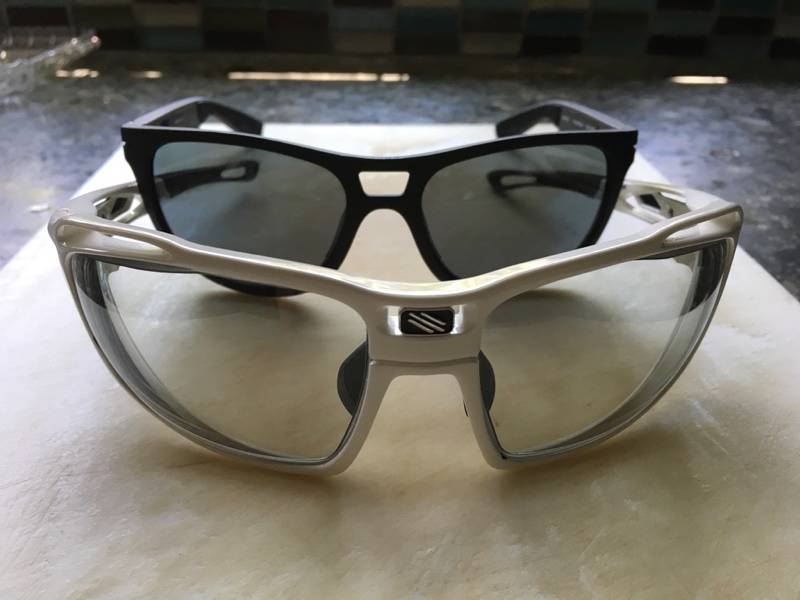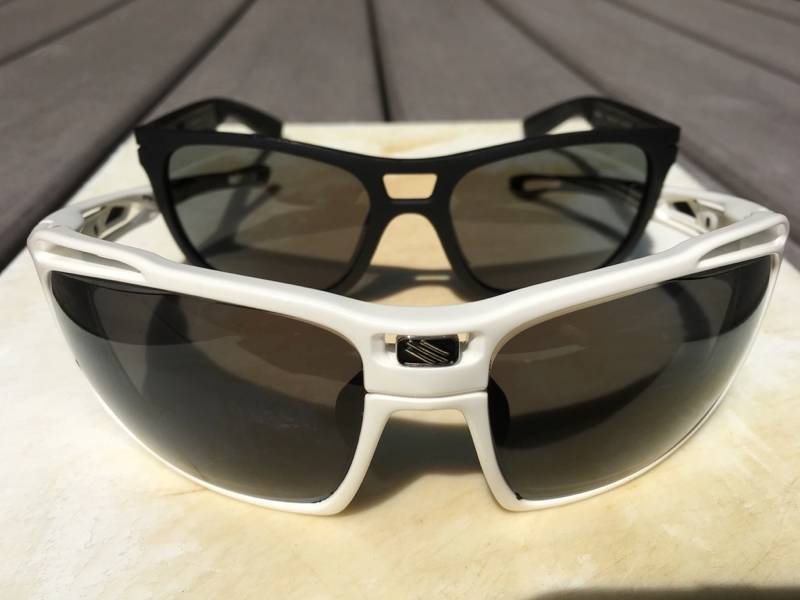To prepare for this year’s 20th anniversary edition of the Race Across Oregon I needed to replace some prescription sunglasses. Since the race was 622+ miles non-stop, we’d be racing through the night. I needed a solution that would handle the bright desert conditions on the east side of the state, as well as clear lenses that would work in the otherworld darkness of 3AM. To complicate my requirements, as a result of serious auto accident back in 1996, my left eye doesn’t constrict (just like David Bowie’s!) and is extremely light sensitive. Even cloudy days in the dark of winter are too bright and I must wear sunglasses whenever I’m outdoors.
The initial plan was to get a pair with prescription inserts and interchangeable lenses.
Instead, based on the recommendation from my optometrist, I opted for photochromic lenses, which had never been on my radar.

The advantage of photochromic lenses for outdoor enthusiasts is simplicity. Rather than needing multiple glasses or interchangeable lenses for different lighting situations, one pair can theoretically handle them all. An overnight ultra cycling relay race was a good test case.
After placing the order I did the research I should have done before placing the order…
As a point of reference, there is an international standard that categorizes lenses based on light transmission:
Category 0: 80%-100% transmission for fashion, indoor use, or cloudy days
Category 1: 43%-80% transmission for low sun exposure
Category 2: 18%-43% transmission for medium sun exposure
Category 3: 8%-18% transmission for strong brightness, light reflected off water or snow
Category 4: 3%-8% transmission for intense sunshine in high mountains and glaciers; not for use when driving or on the road.
Within these categoies, most of us think of “sunglasses” as those in category 3 or 4. My personal preference is at the dark end of the category 3 glasses–8%-12% transmission. I’ve found that glacier glasses also work great in tropical sunlight and desert regions.
Photochromism is a reversible photochemical reaction in which the absorbed light changes dramatically in strength or wavelength when the photochemical is exposed to (usually) ultraviolet light. When the photochromic coating on the lens is exposed to UV light it gets darker; when the lens is moved to a darker location the lens returns to a clearer state. They never return to perfect clearness–even in the dark they have a slight tint.

I’ve only recently noticed photochromics as an option in sporty sunglasses. Historically there have been a couple of problems with photochromics that has limited their utility:
1. The speed at which they darken and lighten. You want your sunglasses to protect your eyes the moment you step into bright light. Having to wait for them to darken doesn’t work for a lot of folks.
2. Temperature can affect the performance of photochromics. Cold tends to make them darker, heat makes them lighter.
3. Since photochromic substances get dark when exposed to UV light, they tend not to work in places like cars where the glass windshield blocks the UV light.
HOYA has developed a new photochromic technology branded as “Sensity” lenses intended to address these problems.
Here is time-lapse video of the lenses changing to dark and then back to light:
I had no way to measure the change in the light transmission, but based on the video it looks like the Sensitys completely darken in about a minute, and completely lighten in about two. For comparison, the glasses in the rear are ROKA Vendée Carbon polarized lenses which transmit 15% of visible light. In researching this piece I wasn’t able to find HOYA’s official take on % transmittance. In general I think it would be helpful if *someone* would independently test photochromic brands to show how they perform in different light and temperature situations.
I brought a couple pairs of glasses to Race Across Oregon, but ended up only wearing the Sensity lenses. I have them mated with Rudy Project Sintryx frames. I was really surprised at how well they performed during the 30+ hours of the race. I only took them off to clean the sweat. They were plenty dark during the brightest part of the day in the arid desert of Central Oregon, and worked perfectly in the middle of the night.

I’ve also been wearing them on a daily basis. Although they do darken in a car, it seems like they darken slower behind a windshield than in direct light. I have a pair of Vuarnet 02 model sunglasses that tend to be my go-to glasses for driving and skiing; the ROKA Vendée’s are probably getting the most use these days–I use them for running, cycling, and general use. I also have a pair of ROKA SL-1s I use for cycling and running.

At any rate, If you are looking to simplify your eyewear collection, take a look at the latest generation of photochromics. HOYA Sensity lenses appear to be the leader for sporty applications at the moment.
*****
Cycling’s Rule #12 is that the correct number of bikes to own is n + 1, where n is the number of bikes currently owned. Although n + 1 is widely employed by cyclists, it applies to a long gear list:
–backpacks
–eyewear
–footwear
–skis
–snowboards
…just to name a few.

Hi Jeni:
The ones I got do have a slight tint in total darkness, but I’ve seen another version that looks completely clear.
That said, I wear them at night quite often with no problem.
They do have a number of coating options, but I’m not sure about polarization. The information they provide online is not very detailed. If you are using them for road cycling, folks advise against polarization because it can block slight variations in the road surface like potholes that you might want to avoid.
Is there a tint on the Sensity Dark when indoors? Or is it completely clear at maximum clarity? Do you also know if there is any polarization option with these lenses?